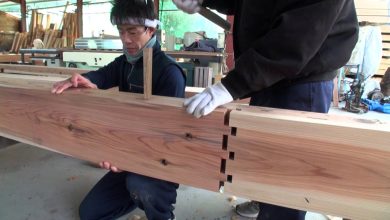Can You Use Spackle on Wood
No, spackle is not recommended for use on wood surfaces.
While spackle is commonly used for repairing small damaged areas in drywall, it is not designed to adhere well to wood.
Wood filler is specifically designed for filling nail holes, gouges, cracks, and imperfections on wood surfaces.
It is sandable, does not shrink, crack, or crumble, and provides a durable finish.
Therefore, it is advisable to use wood filler instead of spackle when working with wood.
Did You Know?
1. Did you know that while spackle is commonly used to repair holes in walls, it can also be used on wood surfaces? However, it is important to note that spackle is not suitable for larger repairs or structural issues on wood.
2. Contrary to popular belief, spackle is not the same as wood filler. Wood filler is specifically designed to repair and fill gaps in wood, while spackle is formulated for use on drywall and masonry.
3. If you decide to use spackle on wood, it is recommended to use a lightweight, shrink-resistant spackle formula. This type of spackle is less likely to crack or flake when applied to wood surfaces.
4. When applying spackle on wood, it is crucial to ensure that the wood’s surface is clean, dry, and free from any loose debris or dust. Properly preparing the wood before applying spackle will help achieve a smoother and more durable finish.
5. If you plan on painting over spackled wood, it is advisable to prime the area before applying paint. By applying a coat of primer, you can improve paint adhesion and prevent the wood’s tannins from bleeding through the paint, resulting in a more professional-looking finish.
Introduction To Using Spackle, Caulk, And Wood Filler In Woodworking Projects
In woodworking projects, there are several sealing and filling materials that can be utilized to achieve a smooth and flawless finish. Three commonly used materials are spackle, caulk, and wood filler. Although they may serve similar purposes, each material possesses unique properties and is suitable for specific applications.
Spackle is a soft substance primarily used for repairing small damaged areas in drywall and filling nail holes on walls. It is typically composed of gypsum plaster, glue, and other compounds. Specifically formulated for drywall repair, spackle is ideal for fixing minor imperfections in walls.
Caulk, on the other hand, is a flexible material used to seal gaps and cracks in joints, edges, and seams. Unlike spackle, caulk is designed to be elastic, allowing it to withstand movement and maintain a watertight seal. It is commonly used in bathrooms, kitchens, and other areas prone to moisture and movement.
Wood filler is a sandable material specifically designed for filling nail holes, gouges, cracks, gaps, and imperfections on wood surfaces. It is formulated to match the color and grain of the wood, making it blend seamlessly with the surrounding surface. Wood filler is an essential tool for achieving a professional and polished finish on wood projects.
By understanding the unique properties and suitable applications of spackle, caulk, and wood filler, woodworkers can choose the appropriate material for their specific needs. Whether repairing drywall, sealing gaps, or filling imperfections on wood, these materials play a crucial role in achieving a flawless end result.
The Benefits And Uses Of Wood Filler In Woodworking
Wood filler is essential in achieving a flawless finish in woodworking projects. It is applied after construction and before staining, painting, or sealing to create a smooth surface by filling imperfections on the wood.
One highly recommended wood filler is the Plastic Wood X All Purpose Wood Filler. It effectively fills nail holes, gouges, cracks, and imperfections in woodworking projects. Unique to this product is its color-changing feature: it goes on pink and dries to a natural, wood finish. This makes it easy to determine when it’s ready to be sanded. Moreover, it is long-lasting, as it does not shrink, crack, or crumble over time.
Another popular wood filler option is the DAP Premium Wood Filler. Acting as a 3-in-1 product, it serves as a wood filler, grain filler, and sealer coat. Its water-based formula allows for accurate matching of existing wood tones. Additionally, it is highly durable, as it does not sink, shrink, crack, or fall out, providing strong impact resistance.
Wood filler can also be thinned with warm water, creating a grain filler for painting purposes. This versatile material is an essential tool for achieving a smooth and flawless surface in woodworking projects.
Recommended Wood Filler Products For Filling Imperfections In Woodworking Projects
When it comes to filling imperfections in woodworking projects, it is crucial to choose the right wood filler product. The Plastic Wood X All Purpose Wood Filler and DAP’s Premium Wood Filler are highly recommended for their excellent performance and durability.
The Plastic Wood X All Purpose Wood Filler is ideal for filling nail holes, gouges, cracks, and imperfections. Its unique color-changing feature allows for easy sanding, ensuring a perfectly smooth surface. Additionally, its non-shrinking, non-cracking, and non-crumbling properties make it highly reliable in woodworking projects.
On the other hand, DAP’s Premium Wood Filler offers a 3-in-1 solution for wood filling, grain filling, and sealer coating. With its water-based formula, it is perfect for accurately matching existing wood tones. Furthermore, this wood filler exhibits exceptional resistance to sinking, shrinking, cracking, and falling out, providing a long-lasting and durable finish.
When selecting a wood filler, it is important to consider the specific needs of your project and choose a product that is best suited to tackle the imperfections you are working to fill.
Using Spackle For Repairing Small Damaged Areas In Walls
While primarily used in drywall repair, spackle can also be used as a wood filler in a pinch. However, it is important to note that wood filler is generally a better option for raw wood, as it is specifically designed to cling and stick to wooden surfaces.
When it comes to repairing damaged areas in walls, such as nail holes and dents, spackle can be a valuable tool. Notable spackle products made by DAP include DryDex Spackling, Alex Flex Flexible Spackle, Fast Dry Premium Spackling, and Alex Plus Spackling. These products are specifically formulated to offer excellent adhesion and seamless repairs.
To apply spackle, a putty knife is typically used to fill the damaged area with the compound. Excess spackle should be smoothed out over the surface, ensuring a flush and even repair. Once dry, the spackled area can be sanded smooth using a sanding block.
It is important to keep in mind that the drying time for spackle can vary, generally ranging from 1 to 5 hours. However, there are also fast-drying spackling products available, which can dry in as little as 15 minutes. Unlike wood filler, spackle is not stainable, as it is primarily intended for use on drywall, stone, and plaster surfaces.
The Differences Between Spackle, Joint Compound, And Other Filling Products In Woodworking And Drywall Repair
In woodworking and drywall repair, it is essential to understand the differences between spackle, joint compound, and other filling products. Spackle is primarily designed for repairing small damaged areas in walls. It is made from gypsum plaster, glue, and other compounds, and is commonly used to fill nail holes and dents before painting.
On the other hand, joint compound is a wet substance used on drywall to seal joints and create texture. It serves a different purpose than spackle, as it is designed to be applied on a larger scale, covering seams and joints in drywall installation. Joint compound typically takes 24 hours to dry.
When it comes to filling smaller holes and damage in drywall, spackle is the preferred choice due to its faster drying time, generally ranging from 1 to 5 hours. Some spackling products can even be painted without the need for priming. Joint compound, on the other hand, requires priming before painting.
In addition to spackle and joint compound, there are other filling products used in woodworking and drywall repair. Caulk, for instance, is a flexible material used to seal gaps and cracks in joints, edges, and seams. Wood putty, another malleable material, is primarily used to fill small holes and damage in woodworking and furniture. Unlike wood filler or spackle, wood putty does not harden once it dries and is typically used after staining, painting, and sealing.
When considering the appropriate filling product for your woodworking or drywall project, it is important to evaluate the specific requirements of the task at hand and choose the most suitable material accordingly.
Check this out:
Frequently Asked Questions
Can you use spackle instead of wood filler?
While spackle may have some limited effectiveness in filling small holes in wood, it is not the ideal choice for this task. Spackle is not specifically designed for wood and may not offer the most satisfactory finish. Although in certain emergency situations, I have resorted to using spackle for filling holes in wood trim, it is always advisable to use wood filler for achieving superior results. Wood filler is specifically formulated for wood repairs and provides a more suitable and durable finish when it comes to filling holes in wood.
Can plaster filler be used on wood?
Yes, plaster filler can be used on wood, although there are some considerations to keep in mind. While all-purpose filler can be applied to wood surfaces, it is important to note that it is not suitable for outdoor use due to its lack of waterproof properties. If you are working on an indoor wood project, plaster filler can effectively repair and fill in gaps or damaged areas. However, it is crucial to use weather-resistant alternatives when filling outdoor wood projects to ensure durability and longevity in various weather conditions. By utilizing suitable products, you can achieve effective repairs while safeguarding the wood from potential damage caused by exposure to the elements.
Can you use DRYDex spackling on wood?
Yes, DRYDex spackling can indeed be used on wood surfaces. Whether it is to fill holes or cracks, DRYDex offers a versatile solution for repairs on various surfaces including drywall, plaster, brick, stone, and even wood. Its ready-to-use formula allows for easy application, providing quick and professional-looking repairs that won’t crack or crumble. Additionally, DRYDex dries to a hard consistency, making it easy to sand and paint, ensuring a seamless finish on your wooden surfaces.
What is the best filler for holes in wood?
Wood putty is the best filler for holes in wood. It is a versatile and easy-to-use material that can be used for both small and large holes. Wood putty is made from a combination of wood fibers and a binder, which allows it to be easily molded and shaped into the desired form. It adheres well to wood surfaces and can be sanded and stained to match the surrounding wood, creating a seamless and natural finish. Whether you are filling in small nail holes or larger gaps, wood putty is a reliable and effective solution for repairing and restoring damaged wood.

